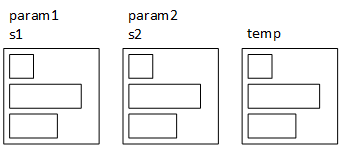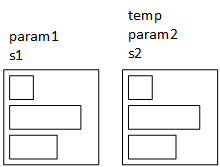int main()
{
student s1 = { 123, "dilbert", 3.0 };
student s2 = { 987, "alice", 4.0 };
print(s1);
print(s2);
swap(s1, s2);
print(s1);
print(s2);
return 0;
} |
void swap(student& param1, student& param2) { student temp = param2; //student& temp = param2; // doesn't work!! param2 = param1; param1 = temp; } |
| (a) | (b) |
 |
 |
| (c - student temp) | (d - student& temp) |
- The driver. The function call doesn't require any special syntax or operators.
- The function definition implements the pass-by-reference. The only curious aspect of the function is that student& temp = param2; doesn't work. Why?
- Recall that pass-by-reference creates aliases by mapping multiple variable names to a single variable. So, the swap function (b) maps param1 and s1 together and param2 and s2 together. temp is a distinct local variable.
- Pass-by-reference makes param2 and s2 the same variable. If we make temp a reference, then it and param2 become the same variable, and therefore, temp and s2 become the same variable. So, the assignment param2 = param1 is equivalent to s2 = s1, which overwrites and looses the contents of s2.